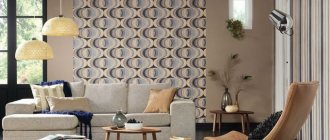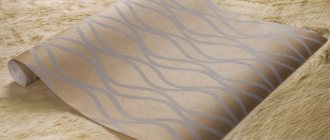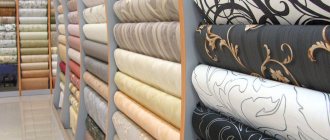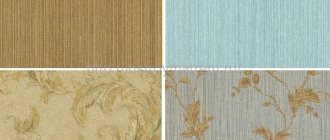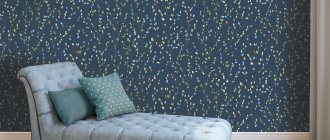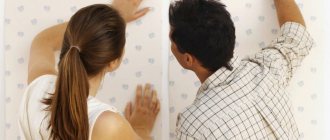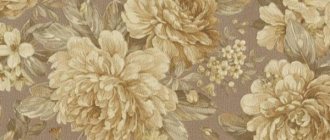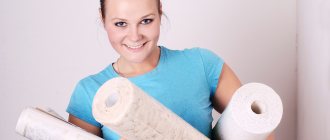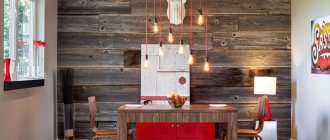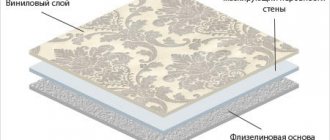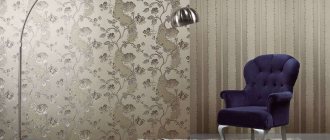Thanks to the large assortment of wallpapers, many people still prefer to see vinyl on non-woven backing on their walls. Actually, what is the difference? And why they attracted the attention of buyers.
It turns out that such wallpaper is much stronger, although it seems to have the same composition as regular paper. Today I will talk about the pros and cons of such wallpapers, and give some tips on how to choose quality ones and not fake ones. And we’ll find out whether it’s true that such wallpaper is resistant to fire.
What is non-woven vinyl wallpaper?
Previously, a paper base was used in the manufacture of vinyl wallpaper. But when sticking it on, it got wet, and when it dried, it shrank.
As a result, the joints could diverge, causing the aesthetics of the room to suffer. For the same reason, they were not suitable for rooms with high humidity.
A non-woven base, such as interlining, does not behave so capriciously. Therefore, vinyl wallpaper with such a base holds its shape and lasts longer. They perfectly cover the surface of the walls, do not get wet from the glue and do not deform over time.
An additional advantage was the feature when pasting, when there is no need to apply glue to the wallpaper strips. It is enough to treat the surface of the wall, apply dry wallpaper to the wall and press it carefully.
It is only important to choose the right texture and color of wallpaper to match the style of the room from the huge range of finishing materials offered on the market.
Selection depending on the room
Wall coverings are selected for different rooms, taking into account the needs that are specific to the room.
Vinyl wallpaper - photo in the bedroom interior
- The coating is not environmentally friendly, so refrain from gluing it in a child’s room or bedroom.
- They are not afraid of moisture and do not fade due to fumes, ideal for the kitchen or bathroom (do not compete with tiles or PVC panels).
- Indispensable in the hallway - they are washed and create a certain atmosphere for the apartment immediately at the entrance, depending on the design.
Pay your attention to the photo wallpaper. You can read about them and see illustrations by following the link.
Characteristics
Vinyl wallpaper on a non-woven basis is a covering that is made without the use of fabric or paper. This coating does not absorb water at all. That is why, when gluing such wallpaper, the adhesive composition is applied not to the canvas itself, but to the walls, which simplifies the work.
Another important characteristic of non-woven wallpaper is its density.
They are much thicker than paper-based wallpaper. That is why they are able to hide roughness on the walls.
Since non-woven vinyl wallpaper is quite dense, it can make the surface of the walls more textured.
Many models are available for painting, so you can change their design. Some manufacturers present models whose quality characteristics allow you to change the design up to 20 times without removing the previous layer of paint.
The wallpaper consists of three layers. The first one is vinyl. It tolerates wet cleaning and even brushing well. Outwardly, it somewhat resembles plastic, but the texture is a little softer. In its original form, it is a material with a transparent texture that can easily be changed in shape during manufacturing.
When applied to a flat surface, it adheres well and can convey any relief and texture.
Vinyl wallpaper on a non-woven basis, thanks to the outer decorative layer, can imitate stone, wood and any textile. The inner layer is a fairly dense composition that allows you to adapt to the walls and mask imperfections. The third layer is a non-woven base.
Vinyl wallpaper can be a canvas for creativity.
You can draw on them and paint them according to your taste. When creating, manufacturers most often use silk-screen printing. Thanks to this, the structure of some tissues is transmitted. Such coatings look presentable.
Foamed vinyl on a paper backing for painting
Like other types of vinyl wallpaper, foam vinyl tolerates painting well using various colors.
This is a great advantage, since it makes it possible to decorate the walls of the future interior not only with an original relief pattern, but also to give it the necessary shade of color.
Wallpaper coverings contain all the advantages provided by a paper base, and also, even after painting, they retain their high properties in terms of environmental safety and breathability of the coating.
It is important to remember: paper-based foam vinyl does not have the required level of mechanical resistance before painting: the coating can be damaged by a fingernail or a sharp object. Therefore, during the gluing process, this material must be handled with care. After painting, the surface will acquire the necessary strength.
Kinds
When making vinyl wallpaper on a non-woven base, the same vinyl is used, but different application technologies allow you to create different appearances. This is how wallpapers are distinguished:
- with foamed vinyl. They have an interesting texture without being too dense. Therefore, such wallpaper is considered “breathable”. At the same time, their advantage is also moisture resistance. They are heavy but provide excellent wall covering;
- embossed with a deep pattern;
- smooth, with a flat layer of vinyl. Such wallpapers are non-porous, but they are perfect for rooms where there is a need to frequently wash the surface of the walls. Such a room in the house is the kitchen. The vinyl layer makes the wallpaper resistant to external influences;
- models for painting. Very popular among similar vinyl coverings. Considered universal for any room, vinyl can be easily repainted several times;
- Silk-screen printing on vinyl wallpaper makes it look luxurious. The manufacturing technology is not simple, and therefore the price of the product is somewhat higher than simple analogues. They are particularly durable and resistant to washing.
What kind of glue is needed?
Vinyl wallpaper with a non-woven backing is heavy and this must be taken into account when choosing an adhesive. There must be a special industrial composition that includes not only an adhesive, but also antibacterial additives. It must be diluted strictly in accordance with the instructions on the package; as a result, a viscous, thick mass is formed.
All manufacturers of wallpaper adhesives have options for vinyl wallpaper in their range. Among the manufacturers there are both Russian and European brands:
- Moment;
- Quelyd;
- Metylan;
- Kleo;
- Pufas.
The glue consumption is indicated on the packaging; it depends on the thickness of the wallpaper and the size of the wall. It should be taken into account that glue is not applied to the wallpaper; it is used to cover the wall. In some cases it is necessary to apply a layer twice.
On average, one pack of glue weighing 500 g can cover 60-80 square meters. m. wall area. This is approximately 4-5 rolls.
How are they different from non-woven ones?
Non-woven wallpaper can be easily distinguished from non-woven vinyl wallpaper. Non-woven models are made from cellulose. Moreover, the non-woven fabric in this case not only serves as a base, but also represents the entire coating as a whole. It resembles paper in composition, but is more durable.
But the difference between models on a non-woven base is the smaller amount of non-woven material.
This material is used only for the substrate, and at the same time it does not perform a decorative function. In this case, it looks more like fairly thick paper. Vinyl wallpaper on a non-woven base has a more interesting design, since the texture of the vinyl can be varied.
You can easily glue and paint them yourself.
Dimensions
For the calculation, information is needed on the width of the sheet and the length of the roll in order to determine how many rolls you will need to purchase for gluing the walls. It is always contained on the factory label. As a rule, vinyl wallpaper on a non-woven basis is available in a wide version: width 100 cm by length 10 meters. But you can also find narrow specimens 53 cm wide in a 10-meter roll.
Some manufacturers sell this wallpaper in other sizes. This depends on the thickness of the vinyl coating and other characteristics of the final product.
Advantages
The popularity of vinyl wallpaper is explained by a large list of its advantages:
- the strength that the use of two layers of materials gives to the coating: non-woven fabric and vinyl;
- resistance to moisture and the ability to wash the surface not only with water, but also with detergents. Some species do well in damp areas, such as the bathroom;
- The durability of vinyl wallpaper is its most important quality. They adhere perfectly to the walls, do not fade, and do not lose their textured pattern;
- universal coating for any type of interior. Vinyl can imitate any material, so such wallpaper can be easily adapted to the desired style of the room. It can create the effect of plaster, stone, brick, wood, fabric, etc.
Flaws
Vinyl wallpapers are not without their downsides:
- they do not “breathe”, or rather the walls lack breathability. This affects the microclimate in the room and poses a threat to the development of bacteria on the wall. To avoid this, before pasting the walls, you can treat them with glue with an antifungal composition and choose wallpaper with a porous structure;
- Difficulty in wallpapering. It is important to choose the right glue and carefully join the sheets. It's usually easier to do this with two people;
- vinyl covering is less environmentally friendly compared to other types of wall materials;
- relatively high cost. However, in terms of durability, they are worth the price.
Price
The table shows the cost of the coating in question from well-known manufacturers:
| Brand | Cost per roll |
| Victoria Stenova Pandora | 2050 |
| Belvinyl | 1700 |
| Rondo | 1650 |
| Marburg Empire | 1930 |
| ERISMANN | 2100 |
Trellis from domestic manufacturer Belvinil
Prices are valid at the beginning of 2022.
Classification
There are several main varieties, and each has its own characteristics.
There are:
- with a layer of foamed vinyl;
- hot stamping;
- silk-screen printing;
- washable;
- hard vinyl.
A few words about each option.
With a layer of foamed vinyl
They are created by applying vinyl to a base using screen printing. High temperatures cause an evaporation process, due to which the canvas forms pores and tears when interacting with vinyl. Wallpaper of this type is dense, which prevents the formation of mold.
There are many varieties: profile foam (with a relief pattern), foam with shiny inclusions, foam on non-woven fabric, etc.
Advantages and disadvantages:
- Foamed vinyl is more environmentally friendly than other types, thanks to its porous structure - it allows air to pass through much better. Another advantage is fire resistance.
- The disadvantage is the insufficient strength of the material. We recommend handling the coating carefully; it is more susceptible to damage than other polyvinyl chloride samples.
Hot stamping wallpaper
Standard two-component variety. Base - paper or non-woven fabric. A layer of foamed polyvinyl chloride is applied, on which a design is printed.
The material is passed through a heating chamber, due to which the vinyl layer softens, and when it is passed through the rollers, the required relief and structure is imprinted on it.
Wallpaper that is thicker is called “compact vinyl.” They are designed to imitate all kinds of structures - stone, brick, untreated wood. Inhibited vinyl wallpaper is the result of entirely chemical embossing.
They are durable and easily react to detergents.
Silkscreen printing
Produced using the hot stamping method: polyvinyl chloride interspersed with silk or artificial threads is applied to the base, after which the stamping is done under high pressure.
The silk-screened canvas consists of two layers, the bottom one comes across both paper and non-woven. The top one consists of vinyl with silk thread. The variability of the structure varies - wallpaper can be smooth as silk or with an imitation texture - plaster or leather.
The motifs of the drawings are floral ornaments and paintings, but if desired, it is possible to move away from the oriental theme and experiment with your own patterns.
Wall coverings are much more expensive than regular ones, and this must be taken into account when you are planning to hang vinyl wallpaper on a non-woven basis in the interior.
Washable wallpaper
Wipe with a damp sponge without causing harm. They are found in the kitchen, where contamination occurs most often.
When choosing such a coating, remember that there are several varieties, each with its own water resistance threshold.
Moisture resistant.
- Can withstand wiping with a damp cloth, but without the use of detergents.
Washable.
- When washing, slightly alkaline products are used; they remove dirt, but not grease.
Super washable.
- Soapy cleaning solutions of any degree of alkalinity are used.
Super washable and abrasion resistant.
- They wash not only with a sponge, but also with a brush.
Hard vinyl
The strength is several times higher than that of ordinary ones (the rapport is about 60-100 cm), and the roll is 15 cm wider. Hard vinyl imitates “Venetian” plaster, painting with rough brushes, leather, silk, gouache, paper, matting.
The wall covering is strengthened with high-quality glue for heavy types of canvas. They must be glued end to end (the joints will not be visible after the surface has dried).
The effect will only work if the surface is perfectly flat.
Other selection criteria
If you are selecting vinyl wallpaper, then the selection criteria that will help you choose the best option may be much more than just the name of the country of origin and the inscriptions on the labels.
Modern design involves a mixture of different materials
The first important step when choosing is to personally familiarize yourself with a sample of the wallpaper that you intend to purchase. Be sure to buy the wallpaper in person, and when you do, smell it. This is a simple and even primitive method, but it is very effective.
If the wallpaper is of poor quality, if its material is harmful to humans and contains negative fumes, then such products will immediately smell sharp and extremely unpleasant.
Many people are skeptical about this method, but in fact, you can verify its objectivity using a very simple method - smell the most expensive European vinyl wallpaper that is available in the store, and then, for contrast, the cheapest. The difference will be noticeable immediately, unless, of course, you have a runny nose. If the smell is already present, then it’s easy to imagine how it will spread throughout the apartment after purchasing the wallpaper and leaving it on the walls for a long time.
One type of vinyl allows you to perfectly imitate natural finishing materials
If you have strong doubts that you can choose the wallpaper correctly and still want to take it, you can do it this way. After all, the house already contains a lot of PVC, for example, in chipboards, plastic windows and other elements.
Article on the topic: DIY designer things: interesting and useful for the interior of the house
But then try to glue such wallpaper in those rooms where you traditionally spend minimal time, or where there is good ventilation (for example, in the kitchen, where there is an exhaust hood), but it’s best not to experiment with the children’s room, only environmentally friendly ones are needed there wallpaper that is not dangerous.
By base type
Vinyl sheets differ in the type of base; the following varieties are distinguished:
- from paper;
- with non-woven fabric.
With paper base
Vinyl wallpaper with a paper backing is more environmentally friendly. The paper “breathes”, so it allows air to pass through “more efficiently”.
- They are preferable for rooms that are not ventilated as often as they should.
- Non-woven fabric is more reliable - paper tears and deteriorates faster.
With non-woven base
It is called a nonwoven material created from cellulose fibers that are held together by a polymer. This is a type of improved paper.
The advantages are immediately visible - it erases more slowly, and its fire resistance is several times greater than that of ordinary paper. Disadvantage - paper base is preferable as a material that is much more environmentally friendly.
Is there any harm?
If the vinyl wallpaper is of high quality, there is no harm from it. But only under this condition, because some unscrupulous manufacturers, in pursuit of cost reduction, do not comply with regulatory requirements for manufacturing.
Based on the second name of vinyl - polyvinyl chloride, an association immediately arises with a chemical element.
Consequently, there is reason to assume that vinyl wallpaper is harmful to health. To make a correct conclusion about whether such wallpapers are harmful or not, let’s talk about their disadvantages.
Vinyl covering with a non-woven base often has a textured surface, the fractures of which become places for dust to accumulate.
Softened by the adhesive, the wallpaper reduces its size as it dries, causing some shrinkage.
Do such canvases breathe or not?
It is believed that materials do not provide vapor permeability, causing the appearance of mold, which leads to various diseases. Manufacturers are trying to provide for this and offer wallpaper with microscopic pores and antiseptic coatings.
After several years of use, vinyl wallpaper begins to emit a carcinogen in the form of polyvinyl chloride, and this chemical component has a negative effect on the respiratory system and central nervous system, and provokes allergenic manifestations.
When the canvas burns, it releases a toxin, which is essentially poison.
How to choose?
When choosing wallpaper, developers ask the same question: “which of them are not considered harmful to health?” In order to avoid the mistake of chasing inexpensive but low-quality material, we will tell you how to choose the right decor.
For those who cannot decide whether non-woven vinyl wallpaper is harmful to health, we advise you to use the following tips:
- high-quality non-woven material has a dense structure, while vinyl remains soft and pliable. To check this, just press on the decorative layer with your fingernail. The vinyl covering will be deformed, a dent will appear on it, and the non-woven fabric will not react to such an impact at all;
- Wallpaper of poor quality can be recognized by its smell. Turpentine and acetone notes will indicate that low quality ingredients were used for production;
- Before purchasing wallpaper material, check whether the canvases provide breathability, or whether this phenomenon is not inherent in them at all. The relevant information must be confirmed by the labeling of the products; in addition, the ability of the wallpaper to allow air to pass through is determined by the presence of micropores;
- The cost of the product and the country where it was manufactured are of some importance. Wallpaper from Italy and England are leaders in quality and safety, but domestic manufacturers are somewhat inferior in this regard. High-quality material will cost you a decent amount of money;
- It is recommended to purchase wallpaper products in large supermarkets and stores specializing in the sale of this type of product. There is always a large selection of high-quality samples;
- The correct adhesive composition is of no small importance. You should not buy cheap mixtures - look for glue made by the same manufacturer as the rolls you have chosen;
- The correct adhesive composition is of no small importance. You should not buy cheap mixtures - look for glue made by the same manufacturer as the rolls you have chosen;
- If you haven’t found out which fabrics are harmful to health, purchase wallpaper material made from paper. They allow air flow to pass through perfectly, prevent the formation of mold, but do not have the strength of PVC material.
If you purchase wallpaper with a vinyl covering layer, their harmful effects on the body can be minimized:
- Wallpaper should be wiped frequently with a wet cloth;
- The room is regularly ventilated.
Preparing the work surface
Before gluing any finishing materials, the working wall must be thoroughly cleaned of old paintings. The procedure becomes more complicated if the walls need to be cleaned of old paper residues that were previously glued with wood glue or PVA. Separate such residues by first soaking them in warm water for a while. When the paper is saturated with water, it is easier to separate them from the wall.
You just need to soak the walls in parts so that you have time to remove all the soaked residues before they dry.
How to properly glue non-woven wallpaper
Gluing non-woven materials does not require any special skills or knowledge. Can be glued to the following surfaces:
- wooden;
- plastered;
- painted;
- concrete;
- plasterboard.
Good breathability ensures free access of air and thereby prevents the formation of mold and mildew under the finishing material. In order to properly glue non-woven fabrics to walls, you need to know some of their features:
Prepare the surface to be glued: use plaster to cover the cracks and smooth out any irregularities.
Treat porous walls (concrete or plasterboard) with liquid wallpaper glue or a special solution. Considering the transparency of non-woven wallpaper, treat the walls with plaster of a similar shade.
The old non-woven material can be left; they will serve as a good basis for new finishing materials.
- Measure the required length equal to the height of the working wall plus 5 cm.
- Use a plumb line to mark a line and use a pencil to draw a vertical line for even gluing of the strips.
- Apply wallpaper glue prepared according to the instructions to the dried surface.
- Let the adhesive composition sit for 10-15 minutes and get to work.
- The canvas itself is not smeared with wallpaper glue.
- Apply it dry to the wall and glue it to the entire surface without forming an overlap; if gluing is not successful, the strip can be separated from the wall and glued correctly.
- The dense structure of non-woven wallpaper allows it to withstand such manipulation without mechanical damage, and also prevents the appearance of gaps between the joints after drying, unlike paper wallpaper.
- Use a hard roller to roll over the pasted wallpaper and expel all remaining air, wiping off any remaining remaining glue.
If the corner is the middle of the canvas, cut it at the fold and glue the individual parts overlapping each other. Do not open windows and doors until completely dry, otherwise the wallpaper may separate from the wall.
If, however, some parts have moved away from the wall, they are simply smeared with glue and glued.
Non-woven fabrics are often used to decorate surfaces for further painting. According to the wallpaper manufacturer's instructions, use a suitable paint and add color to get the desired shade. The paint is applied with a special roller.
It is important to prepare all the required amount of paint at once so that the color is the same throughout the room.
Excess wallpaper from below is carefully cut off and skirting boards are installed.
Preparation for gluing
Before you start directly gluing non-woven wallpaper, you need to first perform some steps. First, you need to measure the room and draw its plan, not forgetting the length, width and height of the room, as well as taking into account window and door openings. Before making the calculation, check the length of the roll - it can be either 10 or 20 meters. Next, divide the length of the roll by the height of the wall, the resulting integer will determine the number of whole strips per roll.
In order to get the total number of strips, divide the perimeter of the room being covered, minus windows and doors, by the width of the roll. Divide the total number of strips by the number of whole strips in one roll and get the number of rolls needed for the job. If the roll is divided into strips with almost no residue, then it is advisable to purchase one more to cover the surface above the door and windows. When purchasing wallpaper with a large pattern that requires selection, take into account the allowance for pattern selection.
List of required tools:
- plumb line;
- ladder;
- scissors or stationery knife;
- ruler for cutting wallpaper after gluing;
- glue bucket;
- a bucket and sponge for washing walls and removing glue residue;
- a rag or some other rags;
- putty knife;
- seam roller;
- glue brush;
- brush for smoothing wallpaper;
- wall leveling material;
- glue for wallpaper, and for moisture-intensive walls a primer is needed - preferably from the glue manufacturer;
- soft roller and brush for finishing corners.
Preparing walls and cutting wallpaper
To successfully apply vinyl wallpaper, and so that it does not come off later, you need to very carefully prepare the walls for work.
So, the first thing you need to do is remove the old wallpaper, especially if it has a dark or bright pattern. To do this, moisten them with water or a very weak glue solution, wait until they get wet and remove them with a wide spatula. If the finishing coating does not come off well and peels off, then remove only the top decorative layer without touching the base.
If necessary, level the walls using putty, smooth out any unevenness with sandpaper, and repair unevenness and chips in the plaster.
If the non-woven wallpaper is light, and the walls are uneven in color, then they need to be covered with a layer of putty that is uniform in color, because the non-woven wallpaper is transparent and therefore the coating can be seen through. For example, if you want to paste over plasterboard boards, then keep in mind that in the places where they are connected there are white areas from the putty, which will also show through. If you then plan to paint the wallpaper, you don’t have to worry too much, because the paint will interfere with transparency, and if not, then conduct a kind of “transparency” test. Turn on good lighting and place a piece of wallpaper against the problem wall and ask your partner to look from afar - is everything okay? If not, then think about what to paint - the wall or the wallpaper.
Moisture-intensive walls (made of concrete, plasterboard and already painted) need to be primed and then dried.
After preparing the walls, you can start cutting the wallpaper. Before doing this, determine the length of the pieces to be cut - measure the height of the ceiling and add an allowance of about 10 centimeters to it. This is necessary to compensate for uneven wall heights and to adjust the pattern. Scissors are used for cutting, but it is preferable to do this with a sharp stationery knife. Mark the top of each piece with some kind of sign so that you don’t stick it “upside down” later. When the preparation is complete, you can start gluing the wallpaper.
Features of gluing vinyl wallpaper
When it becomes necessary to re-glue vinyl wallpaper on a non-woven backing, it is not necessary to remove the wall covering to the base. It would be more correct and easier to remove the top vinyl layer and leave the non-woven base for further use as a leveling base for new coatings.
Vinyl wallpaper can be glued to both walls and ceilings. And the dense non-woven base makes them easy to use and durable.
The only drawback is the airtightness of polyvinyl chloride. This deficiency can cause the appearance of mold and a characteristic odor, so it is recommended to use an adhesive composition with antifungal properties. But modern technology for the production of building materials is improving every day, and wallpaper with a breathable foam layer of polyvinyl chloride has appeared on sale.
Although they are easily deformed, it is better to use vinyl foam wallpaper on a non-woven backing for gluing surfaces in children's and bedrooms.
How to glue correctly (recommendations from the pros)
We invite you to follow and consider how to glue vinyl wallpaper based on non-woven fabric, and how to do it correctly. Technologically, the process is no different from the methods used for gluing other types. The only fact is that the coating is heavy, which means there is a high probability that you will have difficulties choosing the adhesive composition and joining the canvases together.
Preparing walls for gluing
The gluing process requires initial preparation of the wall surface. It must be perfectly smooth, otherwise it will be noticeable. Wallpaper should only be applied to a clean and dry wall.
How to choose a good glue
During the gluing process, it is worth considering the fact that the wallpaper sheets are quite heavy. It is advisable to use a specialized non-woven adhesive composition. Vinyl is also suitable, and it is adapted to the severity of the coating. You can try to glue everything with simple glue, but in this case you should take care of its concentration. If you want to paint wall coverings, then you should figure out which paint and varnish material is best suited for wallpaper for painting, their properties, advantages and disadvantages. First, you should lubricate not just the canvases themselves, but the wall surface - the likelihood that the coating will adhere better will increase. You can also lubricate the canvas, but the walls should definitely be flavored with adhesive. The gluing process should only be done end-to-end and from bottom to top.
Drying time
If you choose non-woven vinyl wallpaper for the kitchen, it will stick and take longer to dry. The duration of drying will directly depend on the climate of the room, and usually the canvases dry for at least a day. For this reason, we suggest closing the room for several days, and then drying will be faster.
Gluing vinyl wallpaper on non-woven backing
Before starting work, the required number of canvases is measured. If this is wallpaper with a pattern, you need to number the stripes according to the sequence of pasting. Non-woven wallpaper is glued end-to-end. Behind the radiators, due to difficult access, you can not glue the material, but simply paint it to match the main color.
But if necessary, glue not a continuous canvas, but small strips.
The gluing of building material near sockets and switches is carried out strictly with the electric current turned off. Remove the fittings and glue the strips in the usual way. Make a crosswise cut in the place of sockets and switches, move the canvas aside, freeing the openings. After complete drying, insert the fittings into place.
To finish the surface with vinyl products, use only special adhesive for heavy finishing materials. The concentration of glue may be thicker than recommended on the packaging and when applying to the wall you should not skimp on it. Excess glue residue and air are expelled with a rubber roller or spatula from the center of the strip to the edges. Glue residues are quickly removed from the canvas.
Otherwise, the entire process of gluing vinyl coverings is the same as for conventional non-woven coverings.
Ease of use and dismantling makes non-woven vinyl wallpaper very in demand and popular.
How to properly care?
Vinyl wallpaper with non-woven backing can be washed. This fact makes caring for them much easier. The degree of exposure to water can vary, but it is important to pay attention to the labeling on the packaging when choosing coatings.
- If the wallpaper is porous , then wet cleaning is acceptable, but it is better to avoid direct exposure to water.
- And if the wallpaper is smooth and dense, then it is super washable and much easier to care for.
Many of these models offer the possibility of cleaning even with a brush. The wallpaper packaging has a corresponding symbol in the form of a brush. If the wallpaper has markings in the form of only one wave, then they can be wiped with a rag, but first you need to wring it out well.
But before moving on to wet cleaning, you need to wipe off the dust from the wallpaper. This is an important care requirement.
This is due to the fact that many models have a textured surface, so dust must be removed with a vacuum cleaner or a dry cloth. Ignoring this may result in dust streaks appearing during wet cleaning.
Only after this can you proceed to wet cleaning. If the wallpaper is not too dirty, then a rag soaked in plain water is suitable for this, but if there are stubborn stains on the wall, then you can use a weak soap solution or even alcohol. Bleach and solvents must not be used.
Also try to avoid using products with an abrasive texture. When cleaning, use a soft cloth or soft sponge.
To wash wallpaper, it is better to move from bottom to top so that there are no marks or smudges from water drops. After cleaning using alcohol or soapy water, you need to wipe the wallpaper again with plain water and then wipe it dry.
Design and palette
Manufacturers present a variety of interestingly designed models, which can be smooth or with a beautiful relief. The new collection is presented mainly with designs in the form of plant or floral prints.
They depict branches and stems of plants, vines, flowers, trees and other green elements.
Models with glitter are no longer relevant, so only models with a matte or glossy finish are available.
Nowadays, both European and Asian motifs are in fashion. Products with oriental designs and matching prints look very bright. But the classic stripe or monogram is an unchanging and always relevant classic, which is also used for the design of vinyl models on non-woven backing.
Models belonging to the same color palette are in fashion, that is, solutions that are not too bright and contrasting. But manufacturers also present rich shades of coatings that can be used to highlight an accent wall or combine them.
Review of manufacturers
Customer reviews show that Germany, Italy and Spain produce high-quality non-woven wallpaper models. Thus, the Italian brands Zambaiti, Quarta Parete, Domus Parati, Sirpi, Portofino, Andrea Rossi present a wide selection of different types of such coatings.
German brands Paravox, Sahco, Hohenberger, Erfurt, Erismann are famous for their high quality production and external presentation.
In Russia, many companies produce non-woven models. In particular, “Slavic” vinyl wallpapers on a non-woven base are popular. These are hot stamping models with unusual and openwork patterns and textures.
Embossed “Slavic Wallpaper” is produced using new and improved technologies.
Catalog of interior solutions!
The catalog helps you choose an option for every taste. We wish you a pleasant choice!
In the children's room
Wallpaper “Germany”
Combining different patterns
Rich pattern
In the bedroom
Combination in the interior
Dark shades
Wallpaper “Italy”
Blue color
In the hall
In a big house
In the kitchen in modern design
With pattern
In the dining room
In the apartment
Interesting texture
